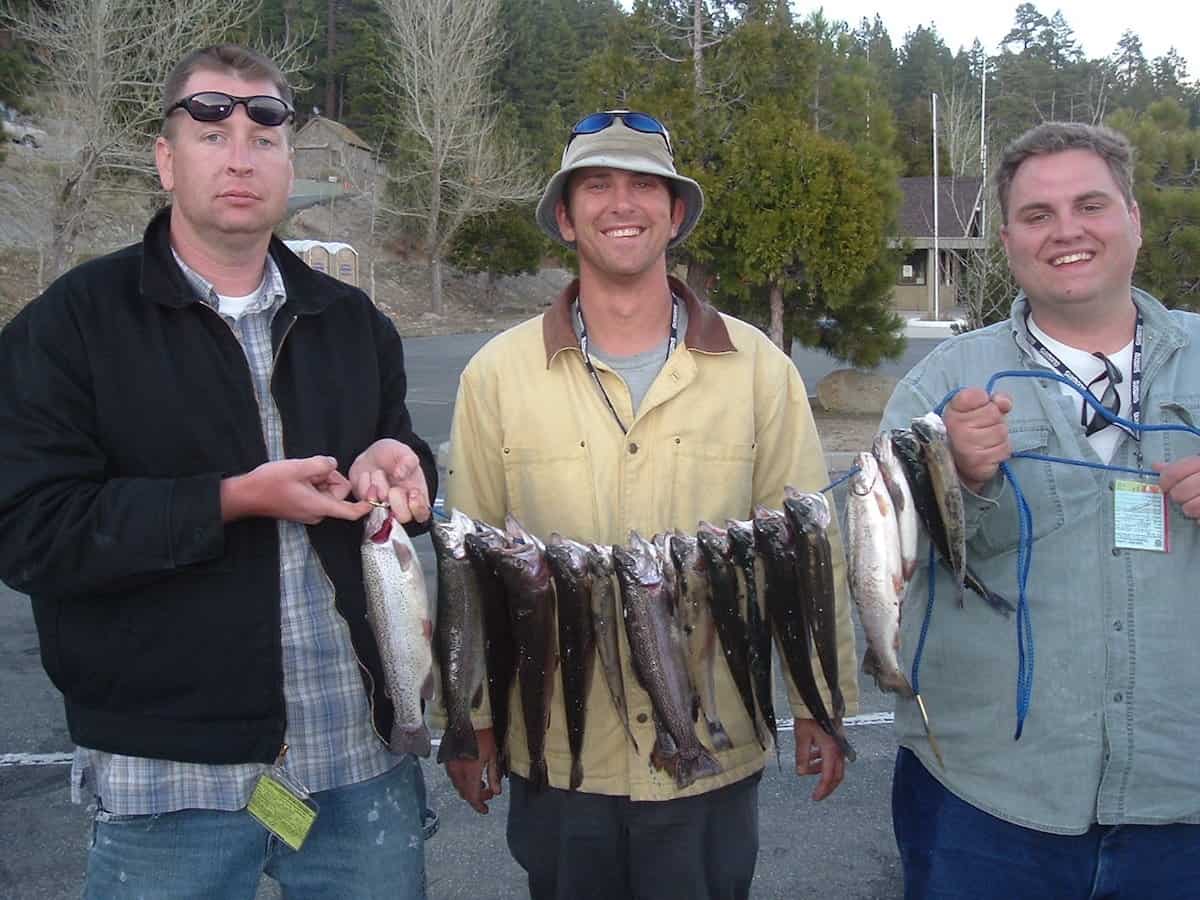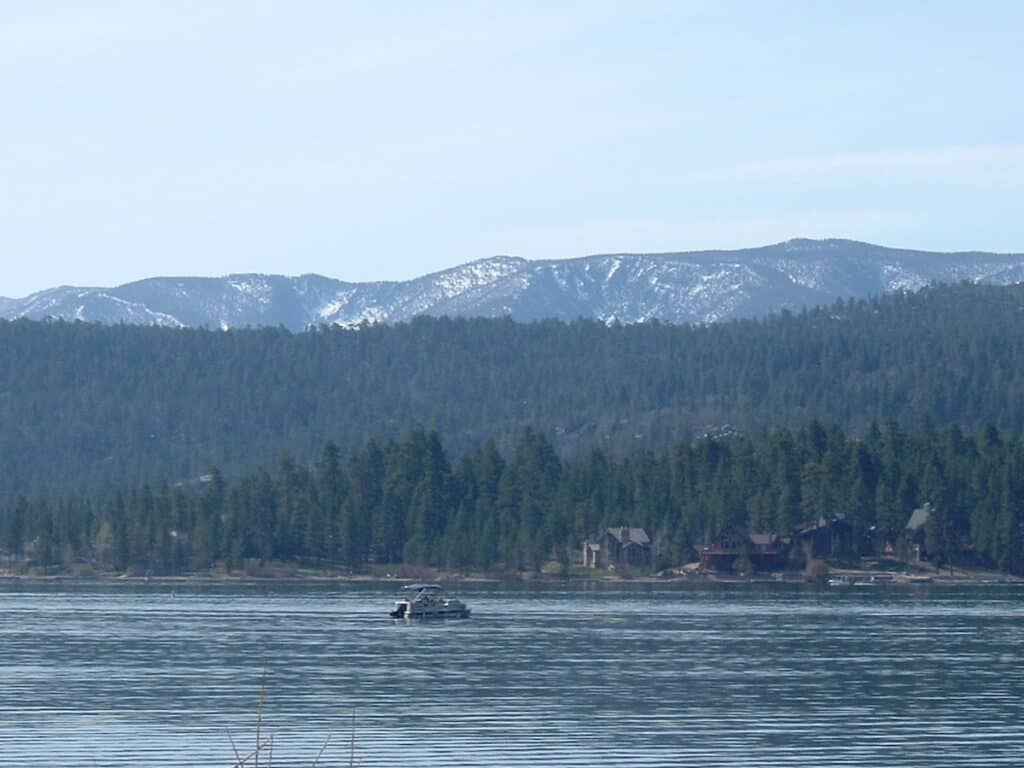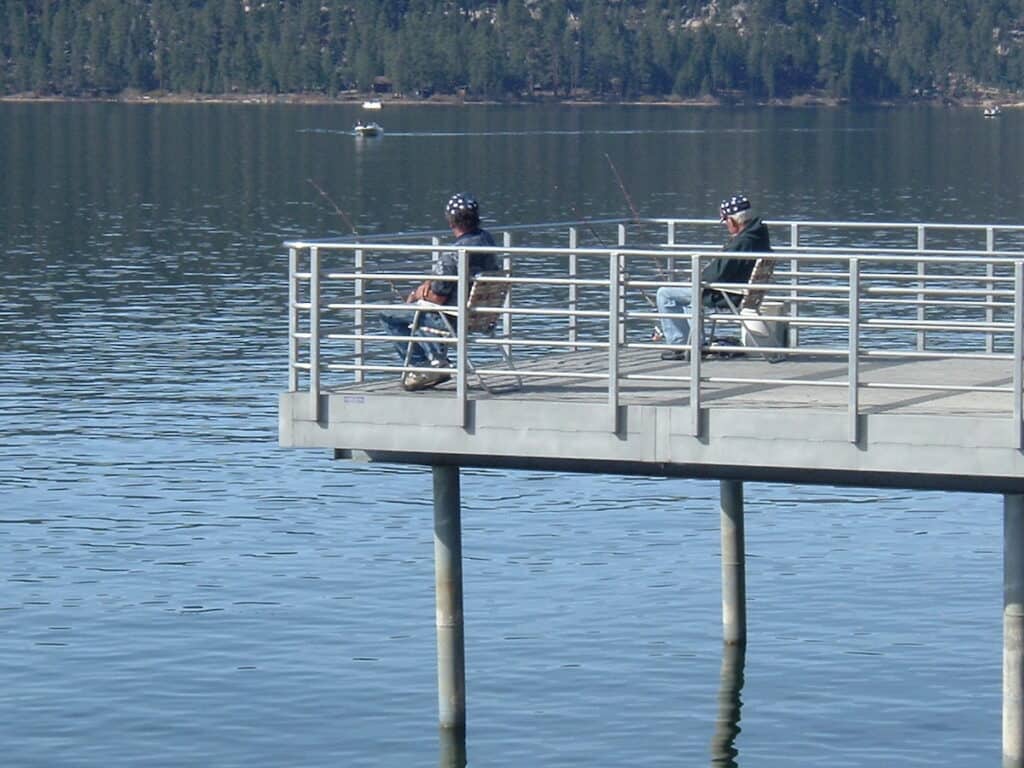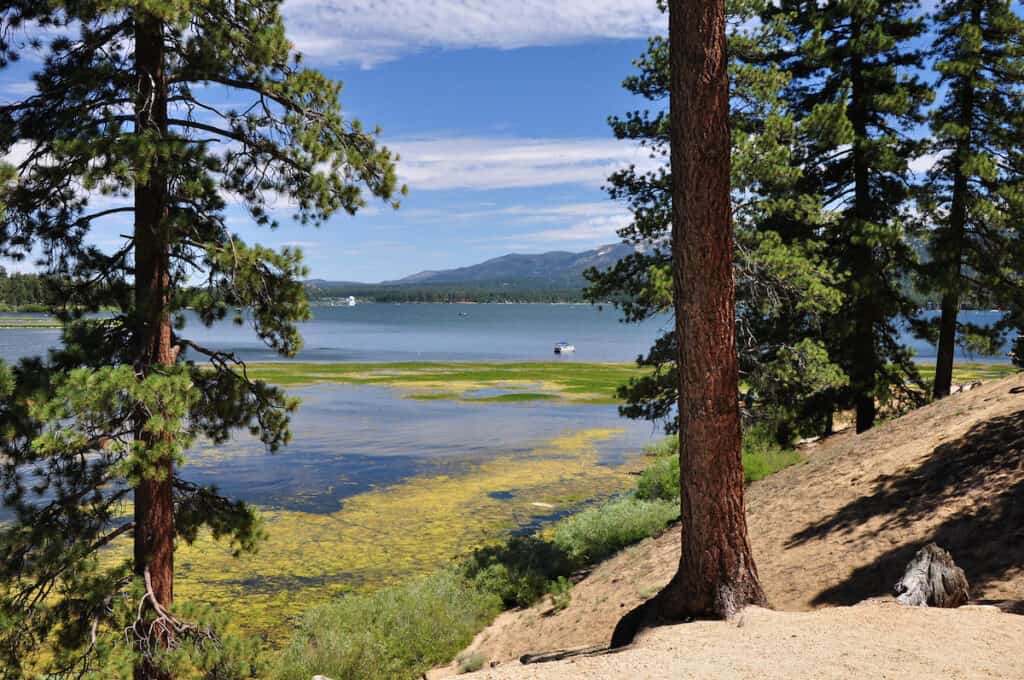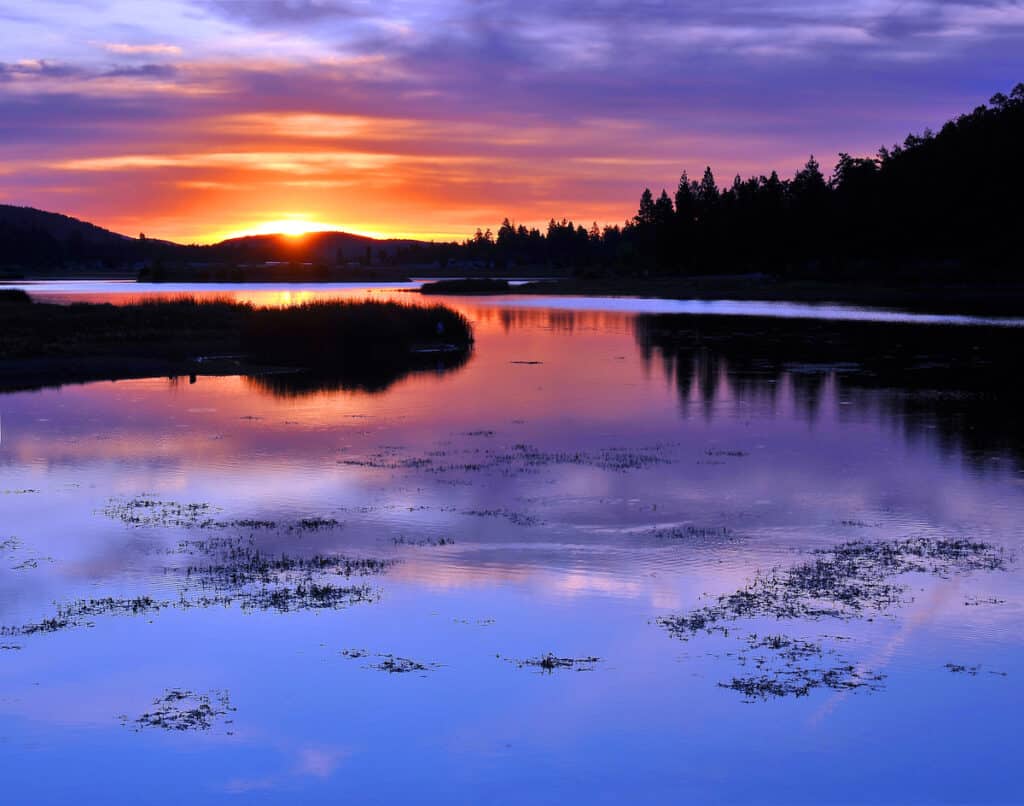Big Bear Lake is nestled in an idyllic mountain scene and offers fantastic fishing opportunities, all surprisingly close to Southern California.
Trout, bass, catfish and other fish species are all waiting to be caught.
Many visit the area to get away from the everyday world while looking for opportunities to golf, hike, waterski, or just sit back and relax.
Why not take the time to get out on the lake and do some fishing?
Situated in the beautiful San Bernardino National Forest, Big Bear Lake has everything a new angler could hope for, plus all the trophy-sized rainbows an expert angler could dream of catching.
The community of Big Bear has everything you’ll need for the perfect base camp, from top-notch amenities to incredible coffee spots. The lake has even more to offer if you’re into fishing.
Trout Fishing
Rainbow trout are the preferred target species at Big Bear Lake. Big Bear offers anglers a fantastic experience, whether you’re just here for a day, a few hours, or planning to visit for a week.
Gear and Tackle
The typical fishing gear to bring to the lake is a sturdy rod that can handle the bigger trout Big Bear Lake has cruising around in its depths, along with the right bait and lures.
Let’s break down the gear and tackle.
Your rod should have a good backbone so it can handle a 10-pound fish, but with enough give to make the more common smaller fish fun as well.
A light to medium action 6-foot-6 rod will do the trick nicely, with a reel equipped with a 6- or 8-pound test. That strength should be strong enough to handle almost any trout in the lake.
Since trout eat minnows, one way to go about this is to try to find lures that mimic minnows. Kastmasters, Rapalas and other lures that resemble forage fish in bluegill or perch colors should work well. Rainbow color patterns also work great.
PowerBait, worms, corn and other options also catch fish, if you prefer bait fishing. Keep the amount of bait light, as oversized baits can cause you to miss more fish than you catch. Be sure to check local regulations before fishing with minnows or other live or dead fish.
Techniques
First and foremost, fish have a great sense of smell, so if you just had a burger or put on some cologne or perfume, fish will smell it and avoid your bait. Rinse your hands in the lake water or rub some dirt in them. That will get rid of any unwanted scents.
Depending on the amount of time you have at the lake, you might decide to rent a boat. If so, trolling can be very productive.
Trolling is one of the most popular fishing methods on Big Bear Lake because you can cover a large portion of water and have your bait at the proper depth the entire time.
Check in with the marina when renting the boat to get a quick walk-through on the ins and outs of trolling. They are happy to simplify the process, and if necessary, will get you hooked up with any extra gear you may need.
When trolling, be sure to check out the west end. It tends to be the most productive area.
Shore fishing works best early in the morning until 9 or 10 a.m., then from close to sundown until it gets too dark to see clearly.
Use a slip bobber set to around 15 feet and head over to the area around the dam for some of the better bank fishing. PowerBait and worms are among your go-to baits here.
Where and When to Fish
Big Bear Lake has several good fishing spots that should be productive, depending on when you’re able to get there.
In the spring through early July, boat anglers have the best luck targeting trout throughout the Pine Knot Landing area through Gilner Point.
Shore anglers do their best at Stanfield Cutoff and around the Juniper Point area in the spring. The bite can be fast from shore when you catch the right day.
Summertime through early fall brings the water sports crews to the lake, making it difficult to troll in certain areas.
The trout tend to move to the northern and southern ends of the lake when things get busy, so if you don’t have one, rent a boat and toss some bait out along the weed beds. Keep moving until you find them. Then it’s game on.
Shore anglers will find some action along Windy Point, Gray’s Landing and North Shore Landing.
There should be good action in the evenings, but if not, at least you’re at the lake, taking in the sun and enjoying the beautiful scenery, so it’s a win-win.
Fall brings a chill to the air and epic fishing to the lake.
Windy Point will provide boat anglers with the best opportunity for giant trout, while shore anglers should do well just about anywhere between North Shore Landing and the Observatory. The area near Bear Valley Dam can also be epic.
And, believe it or not, in exceptionally cold winters, ice fishing can be very good at Big Bear Lake, though more reliable at other great ice-fishing lakes in California.
More Trout Fishing
Pick up more trout fishing techniques and tips in our simple fishing guide.
Bass Fishing
Who doesn’t love the rush of connecting with a largemouth bass and watching it explode out of the water? At Big Bear Lake, that happens all summer long.
Largemouth Bass
Largies in Big Bear Lake are a northern strain, which means they spawn in the summer. That also means they are particularly aggressive once the water temperature hits those summertime levels.
These hungry lunkers like to hang out on the eastern side of the lake, particularly in the larger bays. Target them along the weed lines and throw plastics at anything submerged.
Drop shot rigs with Roboworms, Texas rigs with Senkos, and Ned rigs with a Z-Man or a Robo Ned worm should work well. Darker colors with red flake are the go-to here.
Crankbaits and other lures also will have their days.
Docks and submerged rocks hold good numbers of bass throughout the east side. If the lake is calm, try some topwater lures, or go with crankbaits. If nothing’s drawing their attention, go to a finesse rig setup, and you’ll soon be in business.
After largemouth bass spawn, you can throw almost anything at them, and they’ll hit it like a truck. That lasts for about a week. Use crawfish colors for that extra advantage.
Find the very best largemouth bass fishing lakes in Southern California. (Or, if you prefer, find the best largemouth bass fishing in Northern and Central California.)
Smallmouth Bass
Smallies are everywhere on the west end and along the north shore. These feisty bass are found in great numbers and will snap up soft plastics and crankbaits.
Find any rocky area, especially near the dam, and cast perpendicular to the shoreline. Retrieve your bait, and you’re bound to bring in a smallie.
For their size, these guys put up a great fight.
Work your way from the dam up the west shore and fish until you’re done or at your limit. There are a lot of smallies in there, though they can be stunted due to lack of forage from time to time.
Mid- to late spring and early summer offer the best action, though fishing remains good for smallies nearly year-round because they are native to the Upper Midwest and tolerate cooler temperatures.
Jerkbaits and jigs work well, with jerk baits being the first choice. If these aren’t bringing any fish to the net, go with a finesse setup. Ned rigs have a way of getting the most stubborn smallies to bite.
Check out the very best smallmouth bass fishing lakes and rivers in California.
Catch More Bass
Want to catch more largemouth, smallmouth and other black bass? Check out our Bass Fishing: Simple How-To Techniques and Tips.
Crappie Fishing
There are quite a few great spots to target black crappie in Big Bear Lake, and once you find them, you’re going to fill a bucket in no time.
In particular, crappie show up around the docks and submerged cover.
Pick up some mealworms or wax worms at the marina and take them for a dip at the docks with the kids.
You’ll either find a school of crappies waiting for dinner or a bunch of hungry panfish. Either way, the kids will have fun, and you’ll be able to introduce the next generation to fishing in a beautiful setting.
If you’re out on a boat, head over to the South Shore area and hit the weed beds and anywhere with submerged trees or bushes. The number of crappie in the lake can vary, though the CDFW works to keep them thriving here.
Catch More Crappie
Check out the best crappie fishing lakes in California and then learn how to catch more crappie with these simple tips and techniques.
Bluegill and Panfish
Bluegill are everywhere there’s cover at Big Bear Lake. Weed beds, docks, rocky areas, a little bit of afternoon shade, the shadow cast by the guy standing on the shore over there, pretty much anywhere.
Typical bluegill fishing techniques work here.
Tip a hook with a bit of nightcrawler, add a little bubble to watch for the bite, and cast out 10-15 feet from shore. They tend to nibble, so the float might not sink too hard, or it might completely disappear. Either way, keep an eye on it.
If dock fishing, use the same technique, but instead of casting out, just drop your bait over the side, letting it sink 3-4 feet. Again, watch the bubble.
There are several types of panfish in the lake, and most of them will be right there with the bluegill, so you don’t really need to alter your approach too much to catch any of them.
Catfish Fishing
So you’ve decided that trout are too small, bass are just okay, and panfish aren’t for you.
Maybe it’s time for you to go after some channel catfish. Beware the bait stealing bullheads that lurk beneath the waves. There are tons of them, and they get huge (for bullhead, that is.)
The best fishing spots for catfish at Big Bear Lake are primarily found on the eastern end by the Stanfield Cutoff. Head out that way and soak some smelly baits.
Channel cats love chicken livers. Someone has to. Cut mackerel, shrimp, nightcrawlers dipped in scent, or anything else with a good amount of scent to it will bring them around.
Cast your bait out as far as you can, sit back, and enjoy the evening.
You’ll know when you get a bite because your pole will bend and start trying to get away from you. Let the line go for a moment, then set the hook. Now you’ve got the fish on the hook; you just need to reel it in.
Don’t let the barbs in its fins poke you, which can cause some serious pain. It has one on its dorsal fin (the top fin) and one on each pectoral fin (on its sides by the head.)
Blue catfish also can occasionally be caught with similar tactics, but be aware that this species can grow even larger than the channel catfish, given the right food supply. Best be prepared for battle.
Catch More Catfish
We’ll help you find the best catfish fishing lakes and rivers in California and then we’ll help you catch more of them with Catfish Fishing: Simple How-To Techniques and Tips.
Carp/Bowfishing
There are a good number of carp in the lake, and once a year, Big Bear Lake holds a bowfishing tournament to help thin the numbers a bit.
There’s more information about this from the Big Bear Lake site, as bowfishing isn’t something we’ll delve into much in this article but could be fun if you’re into such things.
Carp fishing can be fun with a rod and reel as well, although with the other species in the lake, there’s usually something a bit more popular available.
Planning Your Trip
Big Bear Lake is a quick drive for anyone in Southern California looking to get away to a pristine alpine destination.
It’s a short two-hour drive from Los Angeles into the mountains of San Bernardino County, and once there, you’ll feel like you’ve arrived in a different state altogether.
Depending on the time of year, you can plan on anything from waterskiing to snowboarding. Big Bear Lake and the surrounding area have all the recreational needs you and your family are looking for.
Boat and Shore Access
Boat access is fantastic here. There are public launch ramps that provide free launches. One is the East Ramp, near the Stanfield Cutoff and the Discovery Center. The West Ramp is by the Big Bear Dam, west of Fawnskin. Nothing beats free boat launches that are well-maintained.
Multiple paid marinas offer tackle shops, food, gas and more supplies. Boat rentals and charter fishing services are available.
Shore access is readily available along most of the lake, with easy access being found near every marina and boat launch. Most shore anglers target the areas near Stanfield Cutoff, North Shore Landing, Juniper Point and Gray’s Landing.
Where To Stay
In Big Bear, there’s always someplace to stay. If you want to camp, check around because there are plenty of options, from rustic camping to glamping.
RV hookups are readily available, as are hotels, resorts, cabins and yurts for rent. The area has several private vacation rentals as well.
Food options are abundant in this popular tourist destination, with everything from fast food to exceptional restaurants, so take your pick. If you forget anything back home, there are places to pick up what you need.
Once you fish Big Bear Lake, you’ll see why so many people keep coming here year after year and why you’ll find yourself marking your calendar for your next trip.

